What does the future hold for the last of the gasometers?
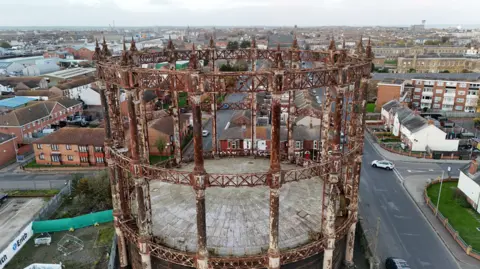 Shaun Whitmore/BBC
Shaun Whitmore/BBCIt was built in the Victorian era and has long since outlived its purpose.
Unlike most of its counterparts, however, the gasometer in Great Yarmouth, Norfolk, has been spared demolition, and could have a very different future ahead of it.
Gasometers, or gas holders, were once landmarks on the skyline of most large towns, but the large, cylindrical structures are no longer needed now that gas is stored underground.
National Grid has been dismantling scores of them across the country.
Great Yarmouth's Grade II-listed example is considered special, however, which is why the firm is investing about £10m to dismantle its tank and restore its cast iron frame.
Now it is asking for ideas about how it could be used in the future.
It has prompted an arts charity to suggest it could even become a venue for circus performances.
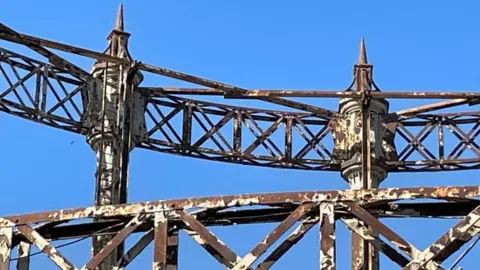 Andrew Turner/BBC
Andrew Turner/BBCBuilt in 1884, it is believed the structure was relocated a year later to its current site due to subsidence.
Standing on Admiralty Road and towering over nearby homes and businesses, the highly decorative details on its frame, columns and latticework led to its listed status.
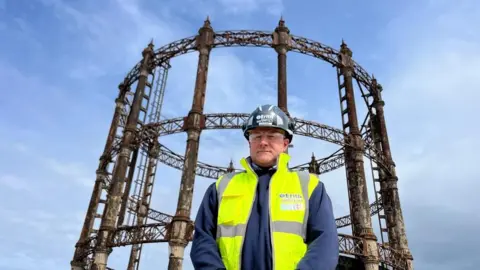 Andrew Turner/BBC
Andrew Turner/BBC"This is the only one that we're saving, and it's very important to the heritage and how old it is," says Gavin Craig, site manager for demolition contractor Erith.
"We've done 125 as a business. I've done 45 and I've been involved in about 80 of them, so we've done them all up and down the country."
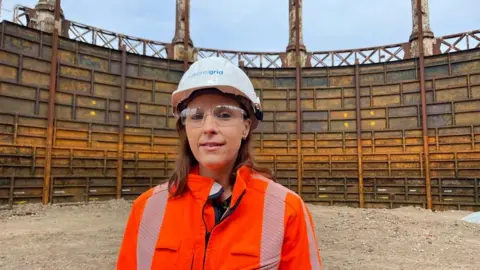 Andrew Turner/BBC
Andrew Turner/BBCNadia McInnes, land regeneration manager at National Grid, explains that as they were not being used, most gasometers - except a few with protected status - have been removed.
"National Grid had a portfolio of over 220 gas holders," she says.
"Over the past 14 years, we've looked to demolish most of them as they're no longer required to store gas, so we've only got a few remaining.
"We will refurbish the frame [in Great Yarmouth] and we are hoping by having removed the tank, we've opened up the site, and then we can bring it back into beneficial use, and any developer with any weird and wacky idea is welcome to come and have a look."
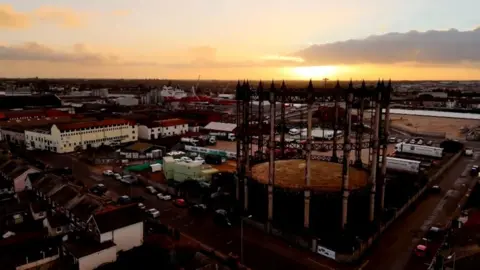 Shaun Whitmore/BBC
Shaun Whitmore/BBCGasometers date back to the early Victorian period when "town gas" was made by partially burning coal to create coke, a fuel that burned hotter than coal.
As the gas was produced, it was stored inside gas holders, which would rise while filling and fall as it was used, maintaining pressure throughout the network.
According to The Gasworks Museum in Fakenham, Norfolk, Britain's last complete gasworks site, the gas was used for domestic lighting, cooking and to run street lamps but was superseded by natural gas, discovered in the 1960s.
The gasometers transitioned to the new fuel, but eventually technology allowed natural gas to be stored within the network at higher pressures, making the landmark structures redundant.
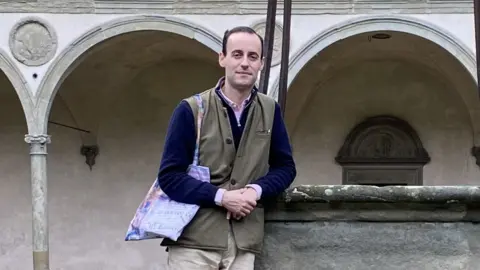 The Victorian Society
The Victorian SocietyHeritage watchdog The Victorian Society objected to National Grid's application to remove the tank, though it has cautiously welcomed the restoration of the ornate frame.
"I think it was important that the tank remained part of the entire structure because there are very few of them," says senior conservation adviser Connor McNeill.
"The large sites across London that have been redeveloped have almost in every case lost those tanks and all that's retained is the framework.
"Great Yarmouth was a rare example of where everything was intact and it's believed the tank itself was a particularly rare form of construction of which very few remain across the country.
"And its importance and historical value will be diminished by the loss of that integral structure and the way it worked."
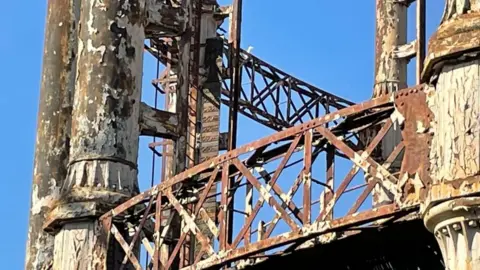 Andrew Turner/BBC
Andrew Turner/BBCHe says the concern is that an important part of the building might be removed without any guarantee about the site's future use.
"That's what we're interested in; finding a sustainable use for these types of structures," he adds.
In response, a National Grid spokesperson says: "The decision to remove the 140- year-old tank was taken after extensive public and stakeholder consultation and a detailed assessment of the condition of the structure.
"The work is being done in line with planning and listed building consent. The removal of the tank will open up the site for a wider range of potential uses in the future once the refurbishment work is complete."
National Grid expects the restoration to be completed by 2027, and says it is keen to hear from any organisation interested in taking ownership of the structure.
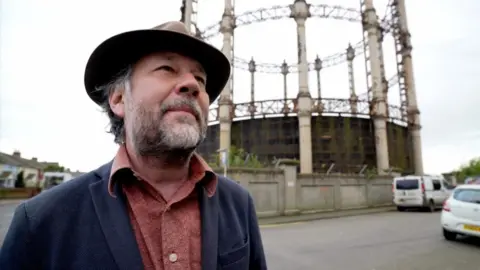 Jonny Michel/BBC
Jonny Michel/BBCJoe Mackintosh, artist director of charity Out There Arts, which runs an annual festival of circus and performing arts in the town, says he has plenty of ideas for the site's future use.
"It's an amazing structure and over the years we've had lots of people express an interest... and say 'Yes, we'd love to do a show there.'
"I've seen lots of performers do all kinds of incredible things with structures over the years.
"There are certainly parkour circus artists who would like to climb all over it; doubtless wire walkers that would be happy to walk from the sides, and aerialists who would be happy to dangle themselves from it.
"I'm sure there would be light and video artists who would like to use it for something; all kinds of things."
Follow Norfolk news on BBC Sounds, Facebook, Instagram and X.
